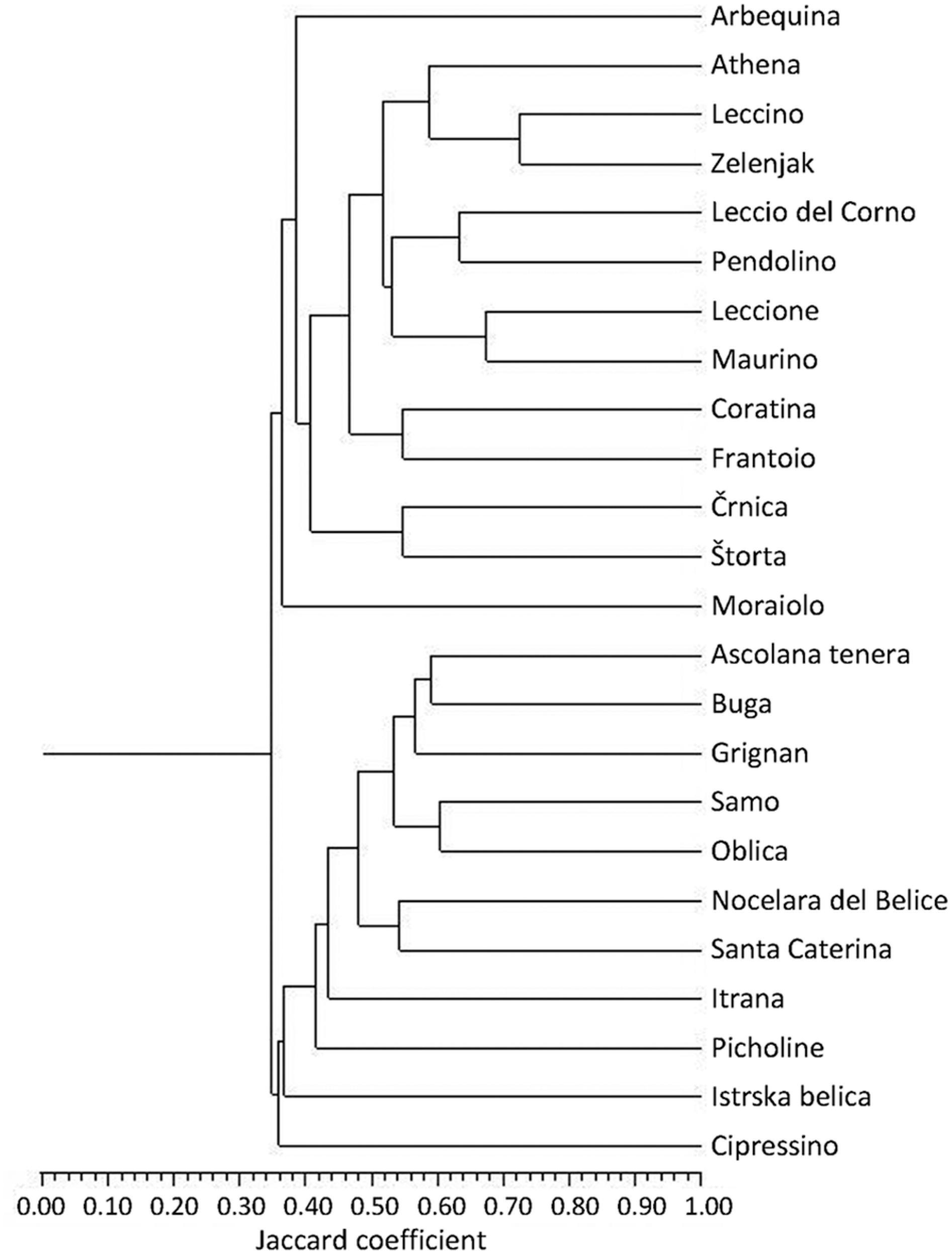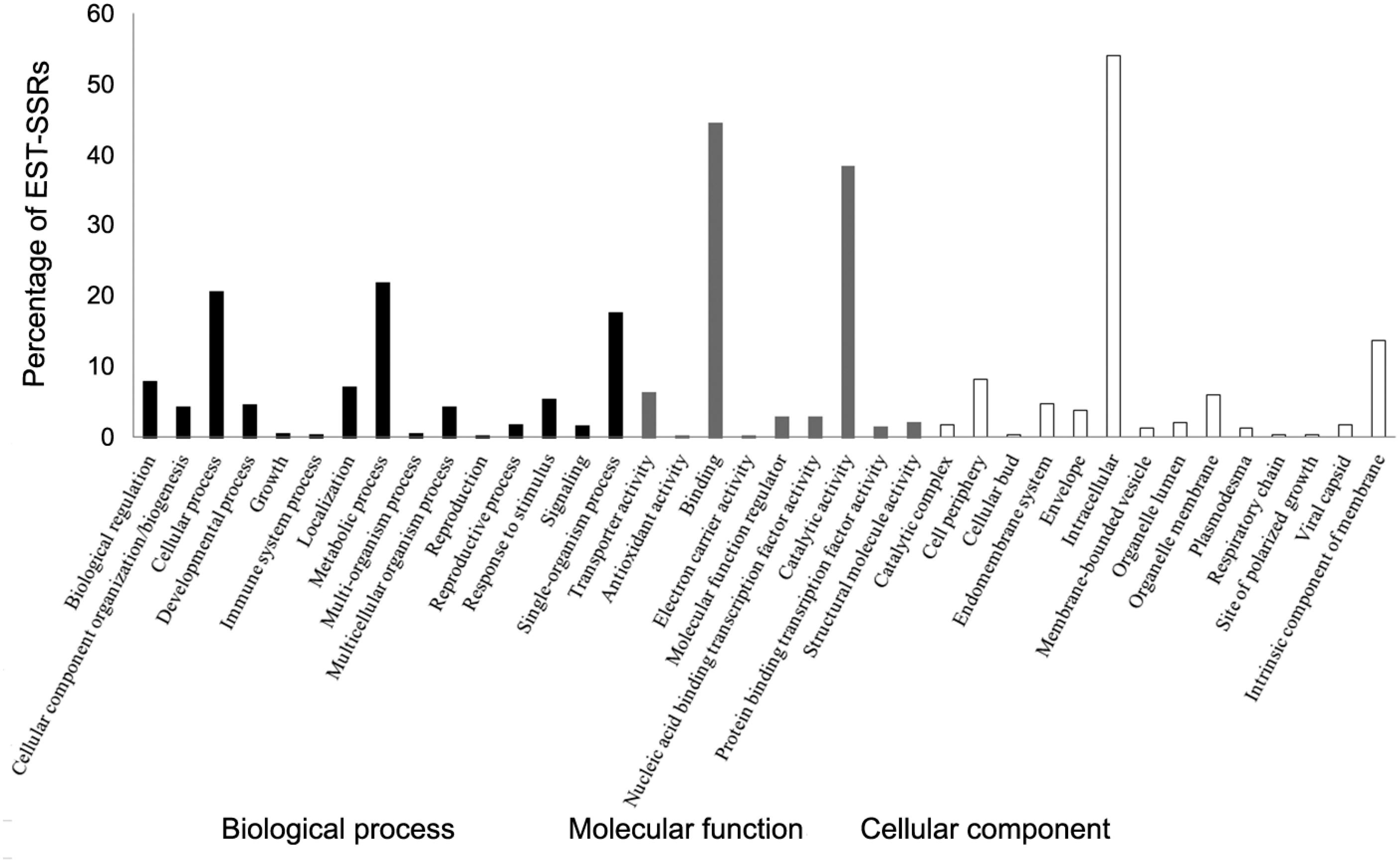| GDUL01003735 |
OeUP-01 |
F: TGTCTCATGCCAGATAAACAG
R: GCAGCAATCCCACAAACTAA |
(AAG)11 |
5′ UTR |
55, 50 |
200-221 |
aquaporin-like protein [Petunia × hybrida]; AAL49750.1 |
| GDUL01018604 |
OeUP-02 |
F: TTTGTCGCTTGCAGATTCCC
R: CTCCCTTACCAGTTGTCGGA |
(TGC)7 |
CDS |
50, 45 |
197-255 |
ribosomal lysine N-methyltransferase 3 isoform X2 [Sesamum indicum]; XP_011076932.1 |
| GDUL01058010 |
OeUP-03 |
F: TCATACGGGCTAGTCGATCG
R: ATCTGCGCTAGTAACACAT |
(TC)13(AC)8 |
3′ UTR |
50, 45 |
166-170 |
pre-mRNA cleavage factor Im 25 kDa subunit 2-like [Sesamum indicum]; XP_011084411.1 |
| GDUL01030423 |
OeUP-04 |
F: TCCGAAATCCCAGTAGAGTTTT
R: GCAGCAGAAATCACCAATCCT |
(TCT)7 |
5′ UTR |
50, 45 |
196-232 |
uncharacterized protein LOC104247946 [Nicotiana sylvestris]; XP_009802414.1 |
| GDUL01046188 |
OeUP-05 |
F: GGCACCAAAGCTAAGCTCAA
R: CCCGGGAAAAGTGTTCTGT |
(CAG)8 |
CDS |
58, 53 |
186-201 |
ethylene-responsive transcription factor ERF113 isoform X2 [Sesamum indicum]; XP_011086885.1 |
| GDUL01026627 |
OeUP-06 |
F: TGAAGTTCCAAGCAGTCCAA
R: CTCTTTCTTCAACAGTGGCTGA |
(TTC)11 |
CDS |
50, 45 |
141-163 |
cyclin-D3-2-like [Nicotiana sylvestris]; XP_009769846.1 |
| GDUL01021889 |
OeUP-07 |
F: TATTGATCACACGGGAATCG
R: AACACAATCCAATCCAAGCTG |
(GA)11 |
3′ UTR |
50, 45 |
207-235 |
phosphatidylinositol transporter, putative [Ricinus communis]; XP_002512943.1 |
| GDUL01011676 |
OeUP-08 |
F: AACGCTCAAGTTCGGTGTTC
R: CCAATCCGGTGGCATGATG |
(TGC)7 |
3′ UTR |
50, 45 |
196-208 |
mediator of RNA polymerase II transcription subunit 8 [Fragaria vesca subsp. vesca]; XP_004296540.1 |
| GDUL01009850 |
OeUP-09 |
F: TGCTTAGAGCCAGAGGACGA
R: CCCAAAATCCATTTTACACCA |
(TGA)8 |
CDS |
58, 53 |
141-156 |
hypothetical protein M569_16005, partial [Genlisea aurea]; EPS58808.1 |
| GDUL01002589 |
OeUP-10 |
F: ACCGGAGCTGAGAATATCCA
R: TCTTCCACTGCCACTACTCG |
(TCG)7 |
CDS |
58, 53 |
212-218 |
zinc finger CCCH domain-containing protein 11- like [Sesamum indicum]; XP_011077389.1 |
| GDUL01041395 |
OeUP-11 |
F: ATAGTAACCACCAGCGCCAT
R: GTGATTGTCATTAAATTGCATCA |
(TGG)7 |
3′ UTR |
53, 48 |
137-165 |
abscisic stress-ripening protein 3-like isoform X1 [Populus euphratica]; XP_011044239.1 |
| GDUL01003880 |
OeUP-12 |
F: GAGCTGCTGGGATAGGACTG
R: CTCGATCCCTCACGTTACAAG |
(TGTA)6 |
3′ UTR |
50, 45 |
140-151 |
proteasome-associated protein ECM29 homolog isoform X2 [Cucumis melo]; XP_008449628.1 |
| GDUL01008284 |
OeUP-13 |
F: CAATAACCCCATCAGCAGCC
R: AGTCCATTAAAACCTTGCAGTCA |
(TATG)7 |
3′ UTR |
53, 48 |
162-174 |
DDB1- and CUL4-associated factor 8 [Sesamum indicum]; XP_011089371.1 |
| GDUL01006921 |
OeUP-14 |
F: TTCCCTTTCGCTTGAAGGTA
R: GTGTGGATGGCGCTTTAGTC |
(AC)11 |
5′ UTR |
55, 50 |
153-165 |
predicted protein [Phaeodactylum tricornutum CCAP 1055/1]; XP_002185470.1 |
| GDUL01000672 |
OeUP-15 |
F: TCTGGGGTTGCTAATTGTAG
R: TTTCCTTCATCATAAAGCTT |
(GTG)7 |
3′ UTR |
58, 53 |
184-190 |
enhancer of mRNA-decapping protein 4-like [Nelumbo nucifera]; XP_010279236.1 |
| GDUL01011852 |
OeUP-16 |
F: CCACCTCCAAGCCTCAGTAA
R: GCCCACGTGCATCAAGAAAT |
(TC)10 |
5′ UTR |
60, 55 |
234-258 |
growth regulator-like protein [Medicago truncatula]; XP_003601898.2 |
| GDUL01008290 |
OeUP-17 |
F: TCTGGCCTGAGACCTTAAACA
R: CGTGGAGTAATTTCATTGGATG |
(GA)11 |
5′ UTR |
50, 45 |
158-167 |
Embryo sac development arrest 6, putative [Theobroma cacao]; XP_007035194.1 |
| GDUL01002948 |
OeUP-18 |
F: TACCCGTTTCCCTTCACTTG
R: AGCTGGTGACCCTACAATGG |
(TCC)9 |
CDS |
50, 45 |
177-200 |
disease resistance response protein 206-like [Glycine max]; XP_003525358.1 |
| GDUL01011678 |
OeUP-19 |
F: TACAATTCATCTGCGGCATC
R: GGCTTCGATTGATTTGCTGT |
(GA)10 |
3′ UTR |
58, 53 |
175-183 |
E3 ubiquitin-protein ligase CIP8 [Erythranthe guttatus]; XP_012839188.1 |
| GDUL01012584 |
OeUP-20 |
F: ACCAACCGAGCAAAGCAAAA
R: TTGCCATCGTCTGAGAGTGT |
(TTC)7 |
5′ UTR |
50, 45 |
191-212 |
hypothetical protein CICLE_v10016930mg [Citrus clementina]; XP_006445829.1 |
| GDUL01010877 |
OeUP-21 |
F: GGCTGAAGTGAAAGCAAAGG
R: GCGGACAAGTGGGATGTACT |
(AC)15 |
3′ UTR |
55, 50 |
190-205 |
intersectin-1 [Nicotiana tomentosiformis]; XP_009631701.1 |
| GDUL01019797 |
OeUP-22 |
F: TAGATTCAAAGGGCGGCTAA
R: GAGGATCTATGGCATCGTCA |
(GA)13 |
5′ UTR |
50, 45 |
153-184 |
MIP18 family protein At1g68310-like [Solanum tuberosum]; XP_006366991.1 |
| GDUL01016632 |
OeUP-23 |
F: CAATTGCTGCTGCTGACTTC
R: CATTCAGTTCCTCCCTTCCA |
(AGA)7 |
CDS |
53, 48 |
194-197 |
senescence-associated family protein [Populus trichocarpa]; XP_006372581.1 |
| GDUL01018333 |
OeUP-24 |
F: ACCAGATGAAAACTCGTGATCT
R: ATACGTTCGTCTAGCAGCCA |
(CAG)7 |
5′ UTR |
53, 48 |
185-200 |
UBP1-associated proteins 1C [Vitis vinifera]; XP_002280767.1 |
| GDUL01023602 |
OeUP-25 |
F: AAACATTTTGCACCATTCCA
R: TCAATTGGCTTCTTCCCTCA |
(ATC)7 |
5′ UTR |
55, 50 |
171-178 |
poly(ADP-ribose) glycohydrolase 1 isoform X1 [Vitis vinifera]; XP_002280371.1 |
| GDUL01004307 |
OeUP-26 |
F: AGGAAGTAGCAGCACCAGTT
R: TCCCTCCTTTCCTGGCTTTT |
(GAT)7 |
3′ UTR |
53, 48 |
177-204 |
60S ribosomal protein L36-2-like [Gossypium raimondii]; XP_012482487.1 |
| GDUL01015903 |
OeUP-27 |
F: GGCTCACCCTTTCAGTTTCA
R: CAGCCCATGAATCAGCATCC |
(TTC)9 |
5′ UTR |
55, 50 |
159-181 |
protein dehydration-induced 19 homolog 3-like isoform X1 [Erythranthe guttatus]; XP_012837687.1 |
| GDUL01057837 |
OeUP-28 |
F:TTTTAGTTCAAACTACATAGGAACGTA
R: CAAGCTGGTGCCTTATGGTT |
(AG)10 |
5′ UTR |
50, 45 |
152-184 |
glutaredoxin-C9-like [Nicotiana sylvestris]; XP_009767693.1 |
| GDUL01000197 |
OeUP-29 |
F: GTCCTGCCTTCAAGATCCAC
R: GCGGTGGCCTGAGATACTTA |
(CA)10 |
CDS |
55, 50 |
205-215 |
protein yippee-like At5g53940-like [Solanum tuberosum]; XP_006358970.1 |
| GDUL01007444 |
OeUP-30 |
F:GAGTCACACTCGTCCCTACCA
R: GAATCGCGCGTGTAACATTT |
(AC)11 |
5′ UTR |
55, 50 |
190-196 |
autophagy-related protein 8i-like [Solanum tuberosum]; NP_001275429.1 |
| GDUL01003407 |
OeUP-31 |
F: CATTTTCCGACCAACTGATGAA
R: TCTTCTTGCGGTTAGGTTGC |
(ACC)8 |
5′ UTR |
60, 55 |
203-212 |
E3 ubiquitin-protein ligase UBR2 [Sesamum indicum]; XP_011077478.1 |
| GDUL01001906 |
OeUP-32 |
F: ACGAACCGTGGCAGTACATT
R: CCTTCCCTTTGCCTGTATGA |
(AGA)7 |
5′ UTR |
55, 50 |
171-188 |
Rubredoxin-like superfamily protein [Theobroma cacao]; XP_007038169.1 |
| GDUL01002038 |
OeUP-33 |
F: ACGTCAACCATGCTTCAACC
R: TCAGTACCGAAGCAGCCATA |
(TCA)7 |
3′ UTR |
53, 48 |
220-234 |
Cold-regulated 413-plasma membrane 2 isoform 1 [Theobroma cacao]; XP_007047094.1 |
| GDUL01058412 |
OeUP-34 |
F: CCTTCATAGGCAAAATGGTCA
R: CACCAAAGCATTTGCAGAGA |
(GA)12 |
3′ UTR |
55, 50 |
193-226 |
xyloglucan endotransglucosylase/hydrolase 3 [Actinidia eriantha]; ACD03213.1 |
| GDUL01009565 |
OeUP-35 |
F: GGTGGGGTCTGAATATATGTCA
R: GGCAATGACTTTACGACAAGA |
(ATT)7 |
3′ UTR |
58, 53 |
225-231 |
hypothetical protein MIMGU_mgv1a003502mg [Erythranthe guttata]; EYU41540.1 |
| GDUL01055178 |
OeUP-36 |
F: TGCTTTCTCATTTTCACCACCA
R: AGACTGCACCACCATCATCA |
(GTC)7 |
3′ UTR |
58, 53 |
142-154 |
ADNP homeobox protein 2 [Tupaia chinensis]; XP_006165827.1 |
| GDUL01015452 |
OeUP-37 |
F: AATGGCTGCGAAATGAGAAG
R: CAAAGATTTCAATTTTGTTCTTGGT |
(TTC)9 |
CDS |
50, 45 |
148-188 |
pentatricopeptide repeat-containing protein, putative [Ricinus communis]; XP_002509440.1 |
| GDUL01057556 |
OeUP-38 |
F: AGAACCACCTCAACCACCAA
R: GTCGTCTGTTGTTGGCGATA |
(CAT)7 |
CDS |
53, 48 |
150-167 |
Serine/threonine-protein kinase HuHRK1 [Hanseniaspora uvarum DSM 2768]; KKA02402.1 |
| GDUL01033407 |
OeUP-39 |
F: TCTCGGTTCCTTCCATTCCA
R: GCGAAACAGAAATACATACAAGG |
(AG)10 |
3′ UTR |
50, 45 |
193-209 |
hypothetical protein L484 004798 [Morus notabilis]; XP_010099372.1 |
| GDUL01030115 |
OeUP-40 |
F: ACCCAGTAGCTTAAATCTGT
R: ACGACGATGCGATTTCTTCA |
(TCT)7 |
3′ UTR |
53, 48 |
179-197 |
High chlorophyll fluorescence phenotype 173 protein isoform 1 [Theobroma cacao]; XP_007023557.1 |
| GDUL01029326 |
OeUP-41 |
F: CGGTGACCCTTTAGCCTGTA
R: ATCAGAGGCTTCGAGGAGGT |
(AAG)7 |
CDS |
50, 45 |
160-163 |
lisH domain-containing protein C1711.05-like [Citrus sinensis]; XP_006482262 |
| GDUL01034902 |
OeUP-42 |
F: CGATTTCAAAGGGAATCGAA
R: ACCCGCAATTTACCATGAAA |
(CTG)8 |
CDS |
58, 53 |
162-183 |
vacuolar protein sorting-associated protein 8 homolog isoform X1 [Vitis vinifera]; XP_002267626.3 |
| GDUL01048166 |
OeUP-43 |
F: AAAATCAAACACAACTTGGCAAT
R: CTTCCAATCTGAAAATGCACA |
(TTC)7 |
CDS |
50, 45 |
195-231 |
TrbL/VirB6 plasmid conjugal transfer protein [Neisseria wadsworthii]; ZP_08940344.1 |
| GDUL01050680 |
OeUP-44 |
F: TCAGGTTCTGGCAAGGATTC
R:TTCATCCCTTCTGCTGCTCT |
(GCT)7 |
CDS |
58, 53 |
149-155 |
protein MEI2-like 4 isoform X3 [Vitis vinifera]; XP_010657314.1 |
| KU709832 |
OeUP-45 |
F: GGCCAATCAATGAACCAGCA
R: AGGGCTTGATTCTAAGCTCA |
(AAG)7 |
CDS |
50, 45 |
145-168 |
flavonoid-related R2R3 MYB 4a repressor transcription factor [Vitis vinifera]; NP_001268129.1 |
| GDUL01050819 |
OeUP-46 |
F: TCTTCCTGGTATTTGTTTCGGT
R: ACAAGAGTATATATGCCACACA |
(AAT)7 |
CDS |
58, 53 |
201-204 |
hypothetical protein [Methylococcaceae bacterium 73a]; WP_045223293.1 |


